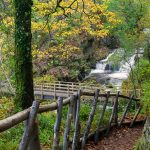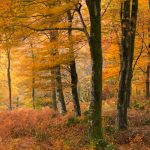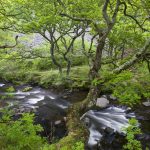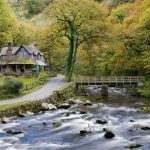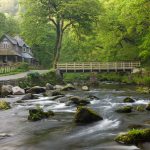Watersmeet is one of Exmoor National Park’s most well-known beauty spots. An excellent network of footpaths follows two rivers, Hoar Oak Water and the East Lyn, through many miles of steep wooded valleys near the North Devon coast. The two rivers converge at Watersmeet and then meander the remaining mile or two to reach the sea at nearby Lynmouth.
How To Get Here
Watersmeet is just 2 miles from Lynmouth on Exmoor’s North Devon coast. From Lynmouth take the A39 out of the village; after a few minutes this narrow winding road will pass a car park on your right. Park here, cross the road and pick up the footpath down through the woods.
Parking
- Parking Lat/Long: 51.223634, -3.8000020
- Parking Grid Ref: SS 744 487
- Parking Postcode: EX35 6NT
- Map: OS Explorer Map OL9 (1:25 000) Exmoor
What to Shoot and Viewpoints
Now in the care of the National Trust, Watersmeet is a very popular destination for visitors. As well as being the starting point for many walks there is a photogenic former fishing lodge, now a National Trust tearoom, which makes Watersmeet a wonderful place to relax with a cream tea and enjoy the beautiful surroundings.
With many miles of footpaths running either side of the two rocky rivers opportunities for great photographs are endless. This whole area requires many visits to truly explore the potential of the place.
- Footpath leading down through autumnal trees to Hoar Oak Water at Watersmeet, Exmoor National Park, Devon, England. © Adam Burton
- Waterfall on Hoar Oak River near Watersmeet, Exmoor, Devon, England. Spring (May) 2012. © Adam Burton
- Autumn colours in Barton Wood, Exmoor National Park, Somerset, England. Autumn (November) 2013. © Adam Burton
- Spring brings a lush green canopy to Watersmeet in Exmoor National Park, Devon, England. © Adam Burton
Viewpoint 1 – Waterfalls
Although both fast-flowing rivers rush and tumble in dramatic fashion through channels between large rocks there aren’t many true waterfalls. Several exceptions however are to be found along Hoar Oak Water,
very close to the old fishing lodge.
The first is easy to find, and passed by every visitor walking down from the roadside car park making this possibly the most photographed view at Watersmeet. When you reach the bottom of the steep gorge, a wooden footbridge crosses Hoar Oak Water. The bridge provides the perfect platform to photograph the river
as it cascades down through a series of impressive falls.
The other waterfall is less photographed but even more impressive. After crossing the footbridge, turn right and climb the steep steps back up the gorge. At the top of the steps follow the wide footpath in a southerly direction, keeping the river on your right. After a few minutes walk you will see a much smaller path veer off
to the right. This leads down to a small railed-off viewing area above an elegant waterfall. The river cascades vertically through a narrow drop for several metres before plunging into a pool. A second waterfall drops further before the river continues its journey towards Lynmouth.
When photographed together, surrounded by woodland foliage this double waterfall makes a lovely picture, especially in springtime when the new leaves are lime green. The challenge of this shot always arises from the restricted viewpoint the platform offers. Sometimes the trees and bushes in front of the railings are overgrown, making a clean shot of the waterfall next to impossible. In this scenario, there is no alternative viewpoint to shoot from forcing you either to compromise or walk away without a photograph.
Viewpoint 2 – Watersmeet House
- Watersmeet House in Autumn, Exmoor National Park, Devon, England. © Adam Burton
- Spring foliage surrounds Watersmeet House next to the East Lyn River at Watersmeet, Exmoor National Park, Devon, England. © Adam Burton
- East Lyn River at Watersmeet, Exmoor, Devon, England. Autumn (November) 2013. © Adam Burton
- Wild garlic and bluebells flowering on the banks of the East Lyn River at Watersmeet, Exmoor National Park, Devon, England. Spring (May) 2015. © Adam Burton
Built in the 1830’s the old fishing lodge (Watersmeet House) is a grand old building which works extremely well when photographed in its river setting surrounded by woodland. Although it is now both a tearoom and information centre, the building still retains its Victorian charms and looks very authentic. If you choose to photograph it during the day you may find the view spoilt somewhat by visitors, but early mornings and evenings will see the area deserted.
The best view of Watersmeet House is from across the East Lyn River, on the footpath below the car park. Before you reach the footbridge you will find a path on the left which leads down to the west side of the river. This path offers an excellent slightly elevated view towards the lodge. Alternatively if you wish to get lower to emphasize the fast flowing water in the foreground of your photo, just continue down the path and you will soon reach the riverbank.
Accessibility
The roadside car park offers plenty of parking, but this is almost at the top of the valley. A steep walk down through well-maintained gravel footpaths is required to reach the rivers at Watersmeet. A note of caution for National Trust members; although Watersmeet is a National Trust location the car park is operated by the local council, so you will need to purchase a ticket.
Mobility parking can be arranged in advance with the tea room at Watersmeet House.
The gravel paths following the rivers are very well maintained, but uneven in places and in some areas climb steeply up the valley sides.
Best Time of Year/Day
As with all areas of deciduous woodland, the best times of year are usually autumn and spring. In both these seasons the trees are going through extreme changes, the results of which are very appealing to photograph. Personally, I feel spring is the best season for this area; the verdant colours on the fresh spring leaves brings the whole area to life.
Whichever season you decide, it is best to time your visit after a period of rainy weather so that the rivers are rushing with good water levels. Avoid sunny days when both visitor numbers and harsh sunlight make photography difficult. A great time to visit this kind of location is on a showery day, when wet leaves give your photographs a lovely saturated look.


